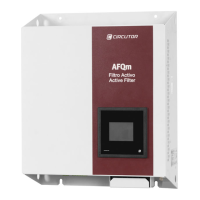38
AFQm
Instruction Manual
4.- OPERATION
4.1.- HARMONICS
Non-linear loads such as: rectifiers, inverters, variable speed drives, ovens, etc., absorb periodic non
sine-wave currents from the mains.
These currents are composed of a fundamental frequency component, rated at 50 or 60 Hz, plus a
series of overlapping currents, with frequencies that are multiples of the fundamental frequency; they
are defined as HARMONICS.
+
+
=
Fundamental
Ware
50Hz
Harmonic ware
5th order 250 Hz
Harmonic ware
7th order 350 Hz
Distorted ware
Figure 32:Distorted wave shape decomposition.
The result is a deformation of the current and, as a consequence, of the voltage, causing a series
of associated side effects. These can be machinery overload, electric cable heating, circuit breaker
disconnection, damage to sensitive devices, etc.
Table 17: Frequency of each harmonic.
Order (n)
Mains frequency
Fundamental: 50 Hz Fundamental: 60 Hz
3 150 Hz 180 Hz
5 250 Hz 300 Hz
7 350 Hz 420 Hz
... ... ...
4.1.1.- BASIC CONCEPTS
It is best to define some terms related to harmonics, fundamental for interpreting any measurement
and study:
Fundamental frequency (f
1
): Original wave frequency (50/60 Hz).
Order of a harmonic (n): A whole number given by the ratio between the frequency of a harmonic
and the fundamental frequency. The order determines the frequency of the harmonic (E.g.: 5th
harmonic → 5•50 Hz: 250 Hz)
Fundamental component (U
1
or I
1
): A sine wave component of order 1 of the Fourier frequency serial
development equal to the original periodic wave.
Harmonic component (U
n
or I
n
): A sine wave component of order over 1 of the Fourier frequency
serial development a whole multiple of the original frequency.

